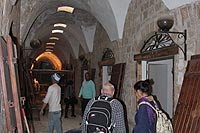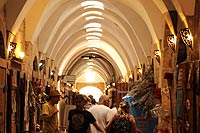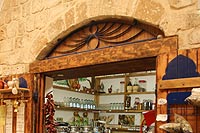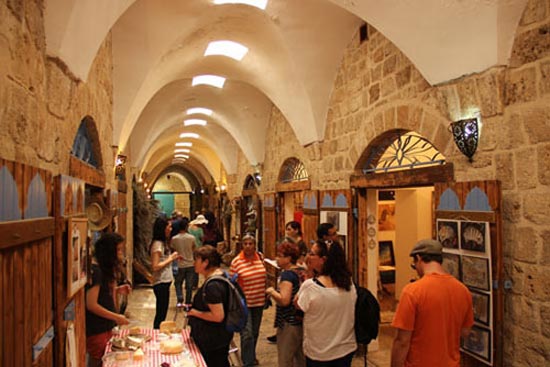 |
Old Akko (Aka; Acre)
Old 'Akko – Conservation, Development and Inspection
Tsilli Giladi, Conservation Inspector
A wealth of cultural values – historical-archaeological, landscape, urban, architectural and artistic, as well as social and religious – is present between and around the city walls of Old 'Akko’, in an area that extends from Tel 'Akko’ in the east to the sea in the west. These values are embodied in built heritage and intangible heritage assets of the city.
|
 |
|
The Turkish Bazaar during renovation, 2013.
|
The preparation of a new master plan was completed just after the turn of the millennium, at the time UNESCO declared Old 'Akko a World Heritage city (2001), and was approved in 2007. For the first time in Israel a conservation addendum based on an urban survey of all the buildings located within the city walls was appended to the master plan. The conservation addendum includes a variety of guidelines, the primary purpose of which is the preservation of the city’s values and which are a “toolbox” for the supervising bodies. Today, 'Akko is in the midst of a process of renewal. The master plan and the UNESCO announcement set forth the conservation policy for the city and its development and the activity of the supervising bodies: the Israel Antiquities Authority, the municipality, the district planning and construction commission.
Since the 1990s the city has benefited from investments in infrastructure, tourism enterprises and urban development; however, it has not been enough. In recent years, those engaged in the conservation of cultural heritage have realized that the preservation of the city will not succeed if resources are not made available for education and raising public awareness. The Israel Antiquities Authority, in cooperation with the municipality and the Old 'Akko Development Company, established the International Conservation Center in the heart of Old Akko. In this way the Israel Antiquities Authority was able to expand its educational activities. The municipality supports the activities initiated by the schools, the Western Galilee College and the community center and encourages them, and the Old 'Akko Development Company is a partner to this agenda.
|
 |
|
Renovation of the Turkish Bazaar, 2013.
|
One of the factors that play a decisive role concerning the future of 'Akko' is the ‘professional committee’, that is, the conservation committee of the Old City. The committee handles applications submitted by entrepreneurs, conservationpolicies, and foresees urban developments. The committee, which is coordinated by the IAA conservation inspector, meets once a month to discuss the issues at hand. The city engineer is the committee chairperson and the head of the Conservation Department of the Israel Antiquities Authority serves as the professional director. Other members of the committee include representatives of the Old 'Akko Development Company, the Society for the Preservation of Israel Heritage Sites, the district planning commission and a representative of the Architects Association. Observers from the city council, the 'Akko Economic Company and residents also participate in the committee.
The Turkish Bazaar. One of the topics presented to the committee for discussion in 2012 was the renovation of the Turkish Bazaar. The bazaar, which was once a bustling marketplace, had deteriorated over time as changes took place in the city. Whenwas built in the 18th century, the now sealed entrance that connected it to the Al-Jazzar Mosque, the city’s largest mosque, was open, the market’s vendors and buyers passed through it five times a day as they rushed to the muezzin’s call to prayer. In recent decades most of the commercial space in the marketplace has been vacated. The main usage of that unique monument was as an exit for the visitors who exit the Crusader through the bazaar. A year ago the abandoned assets were sold off and purchased by a private developer in partnership with the 'Akko Economic Company. The new owners wanted to renovate the spaces quickly and with a minimum investment.
|
 |
|
Renovation of the Turkish Bazaar, 2013.
|
They wanted to promote the bazaar as an exclusive ‘boutique’ type market. The designer presented a plan to the conservation committee. The plan included the use of bold colors and large modern light fixtures. The committee deliberated on the request, and after having visited the site instructed the developer to emphasize the uniqueness and values of the indoor marketplace and to pay careful attention to the use of color and of elements that underscore the spirit of the place and preserve it. Today, after those guide lines has been executed, the wooden doors have been conserved, the plaster has been painted and modest light fixtures have been installed. The bazaar is currently undergoing a renaissance. Delis and artist’s workshops that were opened in it enrich the experience of visiting the city.
Restaurant. Another example of the conservation committee’s activity is the handling of an application for a restaurant. A popular 'Akko’ restaurateur requested permission to open a branch on Salah a-Din Street, along a route that extends between the Land Gate and the Al-Jazzar Mosque. This is a main artery along the length of which are buildings that date to different periods: remains of the city wall from the time of Dahar el-Omar, Ottoman construction, Mandatory construction, as well as building additions that were made after 1948. This route is characterized by a variety of architectural features and notable differences. The building slated for the restaurant has a façade built of sand stone, which is characteristic of the city, but most of the structure is made of modern materials. In comparison to the architectural wealth of 'Akko the building is quite unremarkable.
|
The developer requested planning guidelines from the inspectorate’s office prior to submitting the application to the committee. In this case a student from the International Conservation Center conducted a historical-archaeological survey of the building, at relatively little expense. The survey showed us the development process of the building, thereby making it possible to understand its value and to provide guidelines to the planner in accordance with these values. The cooperation with the developer and the architect working on his behalf, and studying the structure and its values, produced conservation and development plans that facilitated its rapid rehabilitation and the results of the rehabilitation satisfy all of the stakeholders involved in the matter. The rehabilitation of the building and turning it into a restaurant made it possible to expose, conserve and exhibit the only historic wall and have added a layer of local history to the design of the place. The rehabilitation work and the use of architectural elements characteristic of the city have significantly improved its integration into the built fabric and its inclusion in the buildings adjacent to it, specifically from the standpoint of materials, color, the dimension of the openings and the balconies.
|
Renovation of the Turkish Bazaar, 2013. Photography: Yael Fuhrmann-Naaman
|
Today, as in the past, we still face complex issues of conservation and development in the Old City. The daily fieldwork in the Old City, the constant presence over the years of a conservation inspector on behalf of the Israel Antiquities Authority, together with providing solutions to developers and fostering cooperation with the local residents have proven to be the Sustainable way to preserve the uniqueness of Old 'Akko and its continued renewal.
-------------------------
May 2013
-------------------------
|
|













